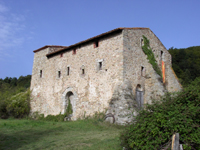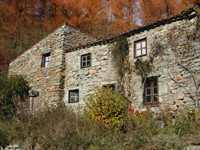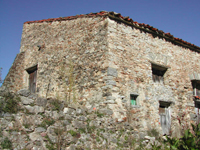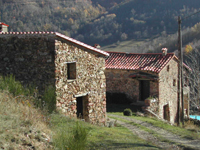el Vallespir |
Can Capellera
Serralonga (Vallespir)El Vallespir, the north of the country of Catalan Farmhouses
El Vallespir is the north Catalan region where the farmhouse is most eminent. This most northern area of Catalunya is home to the farmhouse like no other. In fact, it is this northern tip of Catalunya Vella (Old Catalunya) which defines the farmhouse as a habitat for man; it is the natural continuity of el Ripollès and la Garrotxa. In the past, the region of el Vallespir also included the appending Aspres Mountains, an eastern ridge of the Canigó range that forms part of the Pyrenees. In this area, occupied farmhouses are dominant: more so than in the rest of el Vallespir. In the Aspres there are many villages made up only of farmhouses and their neighbourhoods. (Queixàs, Prunet, Montoriol, Bellpuig dels Aspres etc.).
Therefore, el Vallespir is against the type of repair work to the housing as in “Rosselló without Farmhouses” referred to by Josep Pla—mistakenly in his interpretation of this reality!—that it is but a border country, a battle field for centuries, and therefore very little prone to disperse the farming exploitation and houses. The plains are scattered with Roman “uillae” , which have regrouped and evolved into medieval cellars; In Rosselló there are newer houses in the countryside, characterised by the fact that they are made of cobbles and more significantly tiles.
On the other hand, in el Vallespir, the immense majority of all northern Catalan farmhouses and farm labourers' houses are to be found in the mountain refuge formed by the high and middle Tec basin. It is for this reason that villages now exist such as Montferrer, la Menera, Montalbà or even Reiners where almost all the buildings are farm buildings. Valleys with farms, the necessary “umland” for the urban entities that centred textile or forgery activities at the end of the valley surround towns like Ceret or Arles. Not to mention the millennial town and valley of Prats de Molló which, although is renowned for wool and cloth trade and its “industrial” wool carding and combing collective, counts on villages and neighbourhoods with numerous farms dating back a thousand years making it a prime centre for cattle farming. With the arrival of more modern times and the growth in population, houses are now built mush higher up in the valleys as can be seen in places such as la Percigola o la Presta.
Since the early middle ages, evidence of these constructions has been recorded in notebooks, logbooks, and parchments from different centuries. These have been conserved in public or private archives and are replete with references to the farms and their buildings. In fact, most of the entries registered on file about the region of el Vallespir concern farmsteads.
Agricultural exploitation has continued in much the same way up to the middle of the twentieth century when farming activity began to decline. Firstly, the day labourers abandoned the land in later the farm owners who were unable to survive the social and economic changes of modern times sold their farms at a low price to foreigners who were looking to find a quiet spot in the Mediterranean mountains for their retirement.
The farmhouses are so emblematic in this area that they have given names to the villages and settlements, signifying the importance of this type of habitat: la Presta, les Illes, Can Partera, Benat, la Selva, Alzina Rodona, la Farga Del Mig, el Palol etc.
In the same way the farmhouses in el Vallespir have given the historic names to our people: la Llobera, el Faig, les Planes, el Cremadells, la Vila, el Roure, el Puig, la Figuera, el Verdaguer, el Noell, el Solà, la Boixeda, el Boix, la Costa etc. Which were names given to the houses due a singularity of the spot became the surnames of the respective owners. On the other hand, some families have given their names to the houses: el Vallespir is renowned for being the land of the “Can”. Large properties, large fortunes, gave birth to Can Galangau, Can Guillemó, Can Ribes, Can Rigall, Can Borrell etc., as well as the farmhouses or “Mas”; d'en Camps, d'en Vilasseca, d'en Ribes, d'en Forcada, d'en Perot, d'en Guàrdia etc. a world of names that allows us to reconstruct the very history of the collection of houses in el Vallespir.
The Characteristics of the farmhouses in el Vallespir, suited to steep slopes and quite a humid climate are slightly different from the neighbouring houses of l'Empordà la Garrotxa and el Ripollès. Made from grit and stone slabs these farms were often one large flat single storey house, with stairs lined at the front, adjacent outbuildings, and a surrounding farmyard, the rural building in this area is despite everything synonymous with meekness, or at least, of little magnificence. The coarse mountains, the “uallis asperis” , the rough valley, have generated habits and customs similar to what its name suggests. Evidently, we could find interesting architectonic examples that arise—for different reasons—in the basic standards usually found here. These are some examples of amongst the thousand or so farmhouses in el Vallespir, la Roca, Madeloc de Dalt in Montferrer, Can Pitot, les Esqueroses, Gironella, la Masó in Prats de Molló, Cos and la Llau in el Tec, el Noell, la Masada and el Cremadells in Sant Llorenç de Cerdans, la Batllia in Arles etc.
This is a habitat which portrays the very physiognomy of the countryside in the whole of Northern Catalunya, which joins together the Principality and the Counties through the homes, and which even manages to make the people agree that they are proud to be able to say that they have their origins in that very first building, the Catalan farmhouse.Joan Peytaví i Deixona
Universitat de Perpinyà i Institut d'Estudis Catalans
Can Pitot
Prats de Molló (Vallespir)
Cal Cabús
Prats de Molló (Vallespir)
Mas Casa d'Amunt
el Tec (Vallespir)
el Puig
la Menera (Vallespir)




